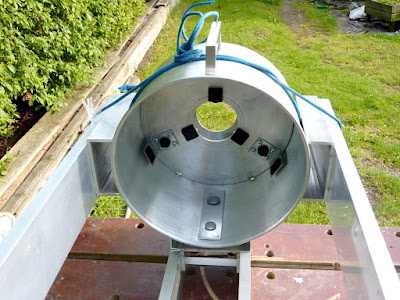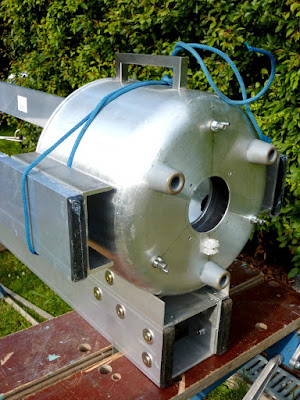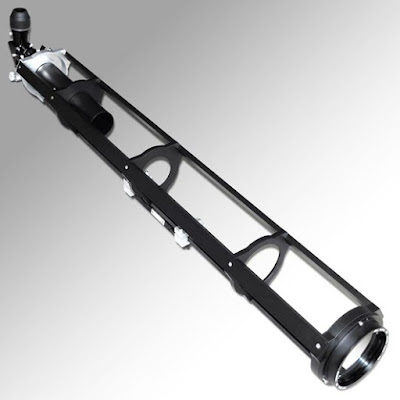*
The image shows the three options tried so far in the search for a lightweight 10" F:8 OTA. All the
OTAs are 2metres or 6'6" long and propped up at close to the same angle.
Carrying the 6mm/ 1/4" thick 30cm/12" diameter cardboard tube around
is very hard work due to its awkward length, considerable weight and
diameter. It cannot be easily bear-hugged for carrying due to its sheer size.
It is far too tall to go through the shed door without bringing it down to the near-horizontal. Adding U-shaped "drawer" handles would help but even the bare weight is
simply too much for me to want to carry it far. That extra weight is a serious hurdle to enjoying the telescope as often as possible. The
"spar" or "rail"" OTA, with its two supporting under-beams is very awkward to carry without the primary
cell handle. This handle is essential to resist the cells swinging strongly to their lowest
position. The all aluminium OTA is also rapidly gaining weight with each new attempt at
torsional reinforcement. Moreover, there is nowhere sensible to attach Dobsonian
altitude bearings on so narrow a spine. They would intrude into the light beam. Even if I could fit altitude bearings the design would need heavy
counterweights to balance the offset masses of the heavy cells.
The
"spar" or "rail"" OTA, with its two supporting under-beams is very awkward to carry without the primary
cell handle. This handle is essential to resist the cells swinging strongly to their lowest
position. The all aluminium OTA is also rapidly gaining weight with each new attempt at
torsional reinforcement. Moreover, there is nowhere sensible to attach Dobsonian
altitude bearings on so narrow a spine. They would intrude into the light beam. Even if I could fit altitude bearings the design would need heavy
counterweights to balance the offset masses of the heavy cells.The twin lateral beams + plywood rings and 3mm / 1/8" thick, cardboard stub tube design is light but unlikely to be stiff enough without many more [and thicker] support rings. It may also prove to need stiffening spars at the top and bottom of the "tube" to help resist lozenging. Altitude bearings are easily attached to the side beams and there are no offset masses or moments. The balance point will dictate whether a [third cage] centre section is required.
I really need to rout some more rings in thicker and stronger material to establish this OTA's true practicality. The present plywood rings are only 10mm thick and feel rather flimsy. My stock of scrap, 18mm [actually measuring 17mm!] multiply Birch plywood feels very heavy in comparison. So 15mm rings may still be too heavy and 12mm BWP Birch ply may be the best option for weight and stiffness. Though that still leaves me wondering about fixing the rings to the cardboard tube and beams. I can't drill through the 12mm thickness of the plywood rings. So may have to add thicker plywood 'tabs' to take short screws and nuts. With luck the tabs can be designed to help to resist the rings twisting on the beams. They could even bridge between pairs of rings to take a greater number of screws.
I still have the 16mm [0.6"] wooden dowels I first intended to use in making an OTA. Though these would require that I rout many more tube rings. Then precision drill them for the multiple, dowel stringers equally arranged on a circle. Such skeleton or cage, tube designs were more popular before triangulated trusses became the norm. An all wooden dowel and plywood ring design would need serious protection from the weather and unheated storage. Attaching Dob altitude bearings to the cage might be difficult unless the tube rings were locally modified.
 There is still no free lunch when it comes to
weight: Eight x 2 meter lengths of 16mm dowel weigh exactly 4lbs. The
30cm bore rings [in 10mm plywood] weigh half a pound each. Unfortunately
the dowel-cage design needs more rings to retain stiffness compared
with aluminium tube. So eight rings are likely to be about the minimum.
8lbs doesn't sound like much, but the mirror, cell, spider, focuser,
finder[s] and secondary have to be added to that figure. The most
immediate problem with a cage is accessing the mirror to cover it.
Leaving out one dowel to make an opening near the mirror would weaken
the cage at the worst possible point. The rings could double as light
baffles but might still require a black, cloth shroud.
There is still no free lunch when it comes to
weight: Eight x 2 meter lengths of 16mm dowel weigh exactly 4lbs. The
30cm bore rings [in 10mm plywood] weigh half a pound each. Unfortunately
the dowel-cage design needs more rings to retain stiffness compared
with aluminium tube. So eight rings are likely to be about the minimum.
8lbs doesn't sound like much, but the mirror, cell, spider, focuser,
finder[s] and secondary have to be added to that figure. The most
immediate problem with a cage is accessing the mirror to cover it.
Leaving out one dowel to make an opening near the mirror would weaken
the cage at the worst possible point. The rings could double as light
baffles but might still require a black, cloth shroud.The image of the latest OTA idea shows a quick mock-up using a second ring on the lower cell. The notches in the rings have been deepened to take the full depth of the 17mm, hollow beams.
The 12" cardboard tubes have an important function in keeping the beams from moving parallel to each other. Or rather, would if there were four supporting rings instead of only three. With just the bare rings there is very little longitudinal stability as the rings easily twist and collapse.
As a belt and braces approach I hoped to source some 2m lengths of 1" square alloy tube. These would to go at the top and bottom of the rings but the only nearby stockist had none in that length. They may well be unnecessary as the beams have such depth that they are very unlikely to bend in the vertical direction. I am still mulling the best [lightest and strongest ] way to fix the beams to the "cells" in a cosmetically attractive way. I don't want to drill bolt holes in the new beams until I am quite sure they will be where I want them and in the correct size.
Click on any image for an enlargement.
*








